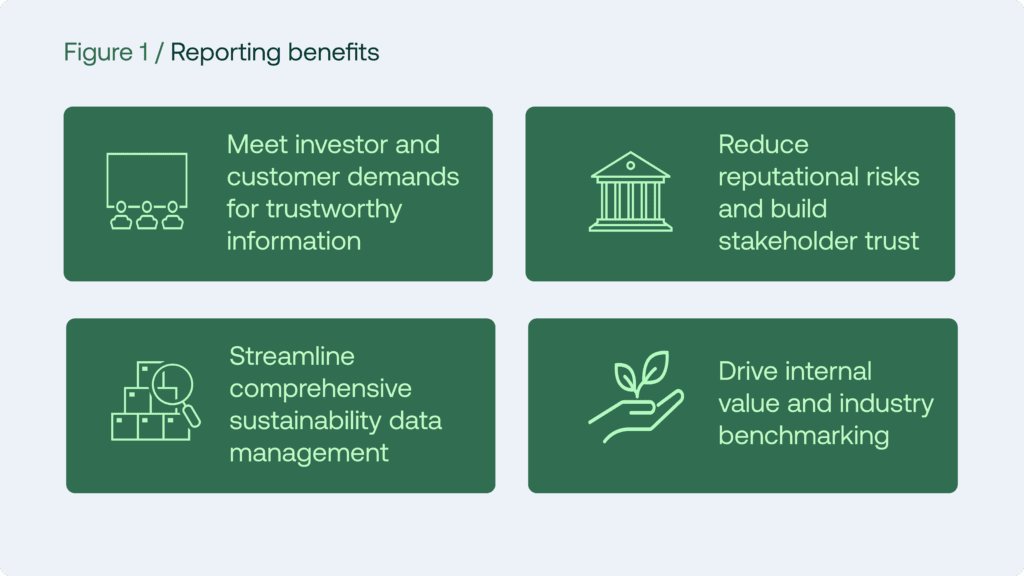 What does double materiality mean for your ESG strategy?
What does double materiality mean for your ESG strategy?
“Transparency through robust, standardised reporting is the most effective way for sustainability teams to mitigate greenwashing risk and win stakeholder trust.”
In today’s sustainability landscape, transparency is not just desirable, it’s essential. Reporting frameworks such as the EU Corporate Sustainability Reporting Directive (CSRD), the European Sustainability Reporting Standards (ESRS), and the Global Reporting Initiative (GRI) provide standardised, consistent, and verifiable guidelines that help sustainability managers build credible ESG disclosures. These frameworks safeguard organisations from greenwashing—a practice where sustainability claims are exaggerated or misleading — by promoting transparency and accountability.
By embracing these frameworks, companies do more than complying with evolving regulations.

What is greenwashing
Greenwashing is the practice of giving a false or misleading impression about the environmental impact or benefits of a product, service, or company. It involves making unsubstantiated or exaggerated claims about sustainability, which can deceive consumers into believing a product or business is more environmentally friendly than it actually is. This includes generic environmental claims without proof, assertions of carbon neutrality through offsets without concrete plans, or the use of sustainability labels that lack certification from recognized authorities.
Greenwashing poses significant challenges by misleading consumers, undermining trust in genuine sustainable products, and hindering progress toward environmental and climate goals. To address these issues, recent regulatory efforts focus on requiring evidence-based, verifiable sustainability claims and banning misleading environmental advertising, thereby promoting transparency and consumer protection in the green transition (1)(2).
State of greenwashing in the world
Greenwashing continues to be a critical issue globally, with increasing scrutiny across various sectors. Recent data shows how this deceptive practice remains pervasive yet evolving in complexity. The landscape reveals a pressing need for transparency and verifiable sustainability claims as stakeholders become more aware and concerned.
Here are three key and impactful statistics on the current state of greenwashing globally:
- In 2025, the number of banking and financial services organizations flagged for greenwashing risk increased by 19% compared to the previous year, with a total of 294 companies identified, highlighting the growing scrutiny in this sector (3).
- A global consumer survey revealed that 91% of consumers believe that at least some brands engage in greenwashing, indicating widespread distrust in environmental claims made by companies (2).
- Between June 2023 and June 2024, global greenwashing cases decreased by 12% for the first time in six years, but the severity of high-impact greenwashing cases surged by 30%, reflecting a shift to more serious violations (2).
Together, these statistics underscore the dual reality of heightened awareness on greenwashing issues as well as the ongoing challenges regulators, consumers, and businesses face in combating deceptive sustainability claims worldwide.
The essentials to avoid greenwashing
Clear, consistent, and material disclosures
Focusing on prioritised, material ESG topics aligned with business impact and stakeholder concerns reduces the risk of superficial or misleading statements. Double materiality reporting—required by CSRD reporting and adopted by GRI—ensures that organisations report both on sustainability risks to the business and environmental/social impacts caused by the business.
Engaging stakeholders to build trust and relevance
Active stakeholder engagement helps ensure that sustainability reports reflect legitimate concerns, fostering trust and authenticity, while documenting engagement creates a transparent trail for claims validation.
Ensuring data integrity and external assurance
Robust data governance combined with independent assurance supports the accuracy and completeness of disclosures. This external verification reduces opportunity for unsubstantiated claims and builds confidence among regulators and investors (1).
How different reporting frameworks ensure transparency
Transparency is foundational to credible ESG disclosure, and multiple sustainability reporting frameworks each contribute uniquely to this goal. The EU’s Corporate Sustainability Reporting Directive (CSRD) alongside the European Sustainability Reporting Standards (ESRS) set mandatory, rigorous disclosure criteria for large companies operating in or trading with the EU, guaranteeing consistent, comparable, and transparent sustainability disclosures (4).
Complementing these mandatory frameworks, voluntary standards like the Global Reporting Initiative (GRI) provide a global, inclusive approach that encourages broad stakeholder engagement and comprehensive impact reporting beyond regulatory minimums (5). The Sustainability Accounting Standards Board (SASB), integrated into the International Sustainability Standards Board (ISSB) standards, zeroes in on financially material ESG factors tailored by industry, helping publicly listed companies provide investor-relevant disclosures (6).
Task Force on Climate-related Financial Disclosures (TCFD) focuses specifically on climate governance, risks, and scenario analysis, forming the backbone of many climate-related reporting regimes worldwide. Frameworks such as CDP complement these by concentrating on environmental disclosures, particularly carbon, water, and forest risks. Together, these frameworks create an integrated ecosystem—mandatory and voluntary, broad and specialised—that sustainability managers can strategically navigate to ensure authentic transparency and mitigate greenwashing risk (7).
Read our latest reporting guide, which compares and connects key sustainability reporting frameworks. Download it for free below!

Double materiality as a strategic lens
Double materiality, a core principle embedded across CSRD, GRI, ESRS implementation and increasingly incorporated in ISSB global standards, requires organisations to disclose both: how sustainability factors affect their financial position and business value, and how their operations impact society and the environment.
This dual lens forces organisations to broaden disclosures from purely financial metrics to encompass societal and environmental impact, delivering transparency that stakeholders seek and reducing risk of selective or misleading reporting. Moreover, it equips sustainability teams with strategic insights to identify systemic risks and innovate in light of evolving sustainability challenges.
 Frameworks as enablers of governance, assurance, and balanced disclosure
Frameworks as enablers of governance, assurance, and balanced disclosure
Sustainability transparency relies not only on standards content but on governance rigour, quality data, and balanced, honest narrative. Reporting frameworks push organisations to implement strong internal controls and cross-functional accountability for sustainability data accuracy.
Independent assurance through audits or third-party verification is increasingly recommended or mandated, adding credibility and making sustainability claims verifiable to stakeholders. Well-developed standards also emphasise balanced disclosure—requiring companies to report positive progress and challenges alike—thereby preventing greenwashing-prone selective reporting.
These mechanisms together foster trustworthy ESG communications, making deceptive claims both riskier and less feasible for corporates (1).
Driving business innovation and resilience
Beyond enhancing transparency and combating greenwashing, sustainability reporting frameworks have emerged as powerful catalysts for strategic growth and innovation. Sustainability managers who leverage these frameworks unlock a host of business benefits:
- Driving operational excellence by using data to identify efficiencies and proactively manage ESG risks.
- Building deeper trust and engagement with customers, investors, regulators, and employees through credible, transparent communication.
- Unlocking sustainable finance opportunities, such as green bonds and sustainability-linked loans, by meeting investor disclosure expectations.
- Fostering innovation in products, services and business models aligned with sustainability goals and stakeholder values.
- Future-proofing organisations by anticipating regulatory changes and positioning as sustainability leaders in dynamic markets.
Embracing reporting frameworks not as mere compliance tools but as strategic enablers equips organisations to create enduring value while safeguarding against greenwashing risks in an increasingly transparent world.
Practical steps for Sustainability Managers
- Conduct robust materiality assessments inclusive of broad stakeholder input.
- Embed reporting responsibilities into governance and operational processes to ensure accuracy and data quality.
- Leverage interoperability between frameworks (CSRD, ESRS, GRI, ISSB) to streamline reporting workflows and avoid reporting fatigue.
Importance of communication
Greenwashing isn’t just about overstating sustainability efforts; it’s also about how those efforts are communicated. Vague or misleading messaging about environmental initiatives can create false impressions and erode trust. For example, highlighting small green initiatives while minimizing larger negative impacts, or using unclear terms like “eco-friendly” without proof, can mislead stakeholders.
Proactively, sustainability managers can embed sustainability deeply into the business by anticipating risks and opportunities, fostering innovation for genuinely sustainable products or services, and engaging stakeholders to build trust. Setting transparent goals and regularly measuring progress helps demonstrate real impact instead of just claims. Promoting a culture of continuous improvement and accountability positions companies as leaders in the green transition while reducing reputational risk
Read our blog about the cost of greenwashing to dive deeper.
Emerging trends that boost anti-greenwashing efforts
- New biodiversity (GRI 101) and enhanced climate reporting standards introduce finer granularity and social dimensions to disclosures.
- Adoption of advanced digital taxonomies and integrated reporting platforms improves data accuracy and stakeholder access.
Take action with Nexio Projects
For sustainability managers, adopting established reporting frameworks is a proven way to ensure ESG disclosures are trustworthy and greenwashing-proof. Transparency built on credible, standardised reporting strengthens stakeholder trust, prepares organisations for regulatory change, and positions sustainability as a competitive advantage for the future.
Nexio Projects helps organisations move from compliance to purpose. Seeing reporting frameworks as more than complaince and as a strategic guide for your organisation’s transparency is one of the ways we can help you to unlock ESG as a moving journey.
Our team of ESG reporting specialists and chartered accountants are experienced in multiple reporting frameworks, including GRI, CSRD, VSME, ISSR and more ESG reporting services. With over 400 successful partnerships worldwide, we empower clients to achieve their sustainability ambitions and make a positive impact. Our expertise spans various industries and regions, delivering tailored solutions that drive meaningful change.
Reach out to Nexio Projects and unlock your strategic potential!
Subscribe to our newsletter for more relevant and updated ESG information!
References
(1) European Central Bank (2025) Corporate disclosure rules and their effectiveness in limiting greenwashing, [online], Available at: https://www.ecb.europa.eu/pub/pdf/scpops/ecb~ae799b1df9.op370en.pdf
(2) European Commission (2025) Green claims. [online] Available at: https://environment.ec.europa.eu/topics/circular-economy/green-claims_en [Accessed 5 Nov. 2025].
(3) European Banking Authority (2024) Progress Report on Greenwashing Risks in the Financial Sector.
(4) Greenomy (2023) CSRD/EU Taxonomy: Fight Greenwashing with Transparency, [online], Available at: https://www.greenomy.io/blog/eu-taxonomy-csrd-transparency-to-fight-greenwashing
(5) EcoActive Tech (2024) Greenwashing vs. Genuine Impact: How to Ensure Transparency in ESG Reporting, [online], Available at: https://ecoactivetech.com/greenwashing-vs-genuine-impact-how-to-ensure-transparency-in-esg-reporting/
(6) neoeco (2025) 2025 ESG Reporting Tools Comparison Guide, [online], Available at: https://neo.eco/resources/articles/2025-esg-reporting-tools-comparison-guide
(7) Seneca ESG (2025) TCFD and related ESG frameworks explained, [online], Available at: https://senecaesg.com/insights/tcfd-vs-sasb-key-esg-framework-differences-explained-2025/











